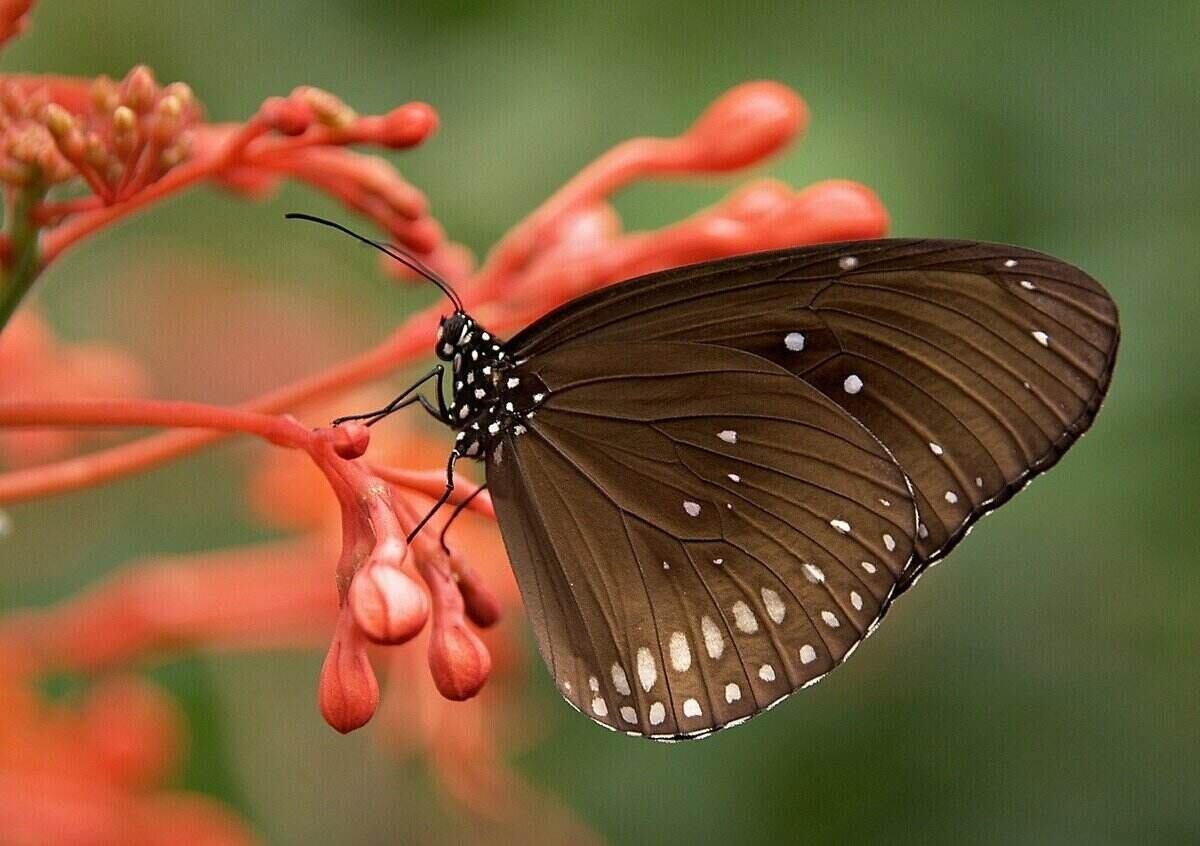
Are you interested in building a butterfly garden with native plants, but not sure where to start? Our guide to butterfly-friendly native plants will fill all your gardening needs – from host plants to nectar plants and everything in between.
Nectar Plants
The obvious first step to create a butterfly garden is selecting plants that are rich in nectar. These butterfly-friendly flowering plants will entice adult butterflies to look for food sources in your garden.
Joe Pye Weed
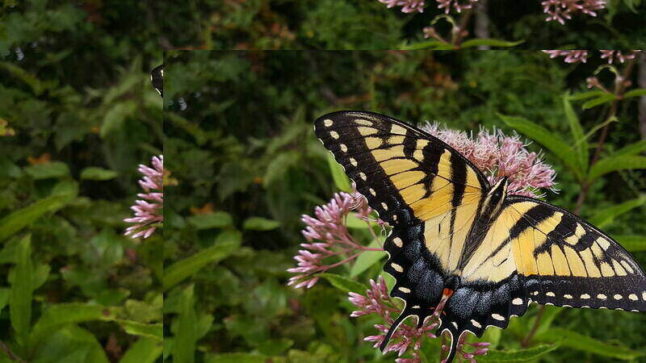
Native to the eastern and central U.S., Joe Pye weed produces distinctive tall purple blooms. The flowers have a vanilla scent that’s lent itself to nicknames like “sweet Joe Pye weed” and “sweet-scented Joe Pye weed.”
Despite its “weedy” name, this flower is great for your garden. It’s particularly attractive to monarch, tiger swallowtail, and viceroy butterflies.
- USDA Hardiness Zones: 4-9
- Examples of Joe Pye weed varieties: Eutrochium purpureum (eastern and central US), Eutrochium dubium (East Coast), Eutrochium steelei (Appalachia)
- Mature size: 3 – 12 feet tall and about 2 feet wide
- Blooms: Large groupings of tiny flowers, typically pink, white, or purple; July-September
Fragrance: Vanilla scent, more intense when crushed - Watering: Does best with deep, regular watering
- Sun exposure: Full sun to partial shade
Additional notes: Joe Pye weed needs extra room to grow, as it will eventually form large plant clusters. When the center flowers in a cluster die out, the halves can be divided and replanted in different areas.
Cost: Buy Joe Pye weed from a nursery due to the difficulty in cultivating it from seed; Eutrochium purpureum is available from $15.95 at Bluestone Perennials.
Blue Vervain
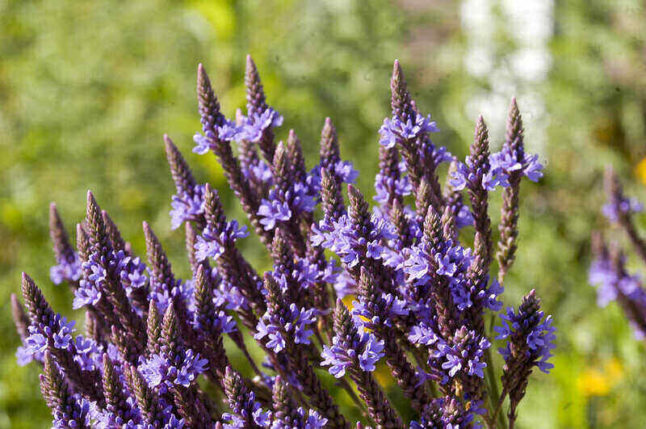
Blue vervain is native or naturalized from Maine to California and nearly everywhere in between. Also known as “simpler’s-joy,” “blue verbena,” and “swamp verbena,” this tall wildflower is known for its attractiveness to buckeye and monarch butterflies.
Blue vervain also has a wide range of medicinal uses, which range from improving sleep to curing acne, headaches, and depression. “Verbena” is Latin for “sacred plant.”
- USDA Hardiness Zones: 3-8
- Examples of blue vervain varieties: Very similar to hoary vervain (zones 3-8) and narrowleaf vervain (zones 5b-10a), which will also attract pollinators and require less moisture
- Mature size: 4-6 feet tall
- Blooms: Pencil-like spike clusters of small blue-violet flowers; June-September
Fragrance: Not to be confused with lemon verbena – blue vervain emits no scent. - Watering: True to its swampy nickname, blue vervain prefers moist to wet soil conditions.
- Sun exposure: Full sun
Additional notes: Seeds should be planted directly outdoors in late fall, as cold weather will break dormancy in time to germinate in the spring. Blue vervain pairs well with Joe Pye weed.
Cost: Seed packets start at $3 at Prairie Moon Nursery.
Zinnias
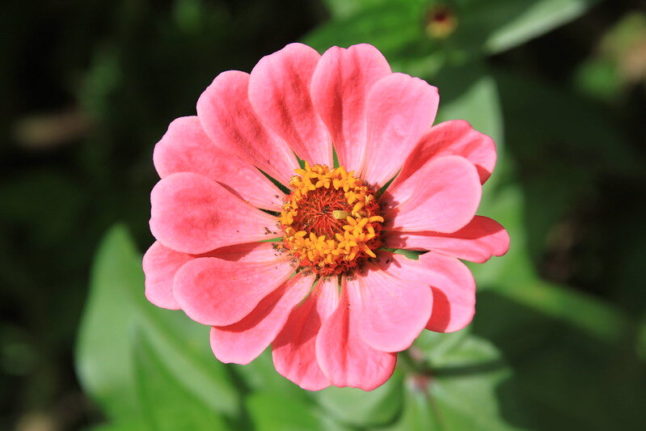
Native to the Southwest, these members of the aster family are drought-resistant and come in a gorgeous array of colors. Like their black-eyed Susan and coneflower relatives, they’re known to attract monarch and swallowtail butterflies.
Zinnias also attract natural garden predators like wasps and ladybugs, which keep pesky aphids out of your garden without the need for harmful pesticides.
Zinnias are so easy to grow that they’re a popular choice for gardening with children and for scientific experiments. In 2016, astronaut Scott Kelly even grew zinnias in zero gravity on the International Space Station!
- USDA Hardiness Zones: annuals in 2-8, perennials in 9-11
- Examples of zinnia varieties: Cactus Zinnias (zones 3-8), Mexican Zinnias (zones 11-12), Oklahoma Zinnias (annuals)
- Mature size: 1-3 feet tall for smaller varieties; 3-8 feet tall for larger varieties; about 1-1 ½ feet wide
- Blooms: Round flowers in warm, tropical colors; late spring through late fall
Fragrance: Zinnias are gorgeous but unscented. - Watering: Though drought-tolerant, zinnias prefer moist soil, so water deeply a few times a week.
- Sun exposure: Full sun
Additional notes: Zinnias don’t like to be transplanted, so plant them into the garden directly from seed. Don’t plant until the last frost has passed, and find a spot with good air circulation to avoid powdery mildew.
Cost: Seed packets start at $3.95 at Eden Brothers
Host Plants
While nectar plants may be great for attracting butterflies, host plants make your garden somewhere they can thrive. These plants will provide food sources for caterpillars and sites for egg-laying and chrysalis formation, making your yard the perfect place for butterflies to settle down.
Milkweed
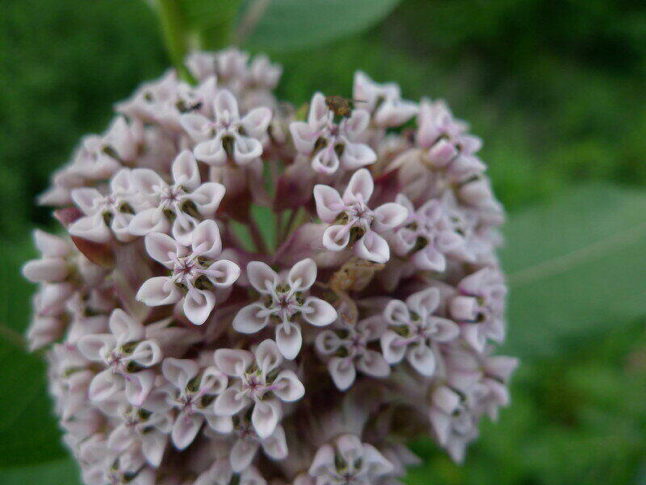
Milkweed is famously the host plant for the monarch butterfly, but it also attracts plenty of other butterfly species, as well as beneficial predators. Its asclepias family has over 100 native varieties across the U.S., including the aptly-named butterfly weed.
- USDA Hardiness Zones: 3-9
- Examples of milkweed varieties: Common milkweed (zones 3-9), swamp milkweed (zones 3-9), Antelope-horns milkweed (zones 7-9)
- Mature size: 2-4 feet tall
- Blooms: Clusters of tiny flowers, with color depending on variety – white, pink, orange, yellow, or red; June-August
Fragrance: Varies, but often described as sweet and spicy, or similar to jasmine - Watering: Won’t need watering except in the driest conditions, and overwatering can lead to a lethal fungus.
- Sun exposure: Full sun
Additional notes: Milkweed will tolerate poor soils, but doesn’t do well in extended heat or humidity. Wear gloves when handling as the sap can be a skin irritant.
Cost: Due to their benefits to butterflies, milkweed seeds are available for free from the Live Monarch Education Foundation and other organizations!
Hollyhock
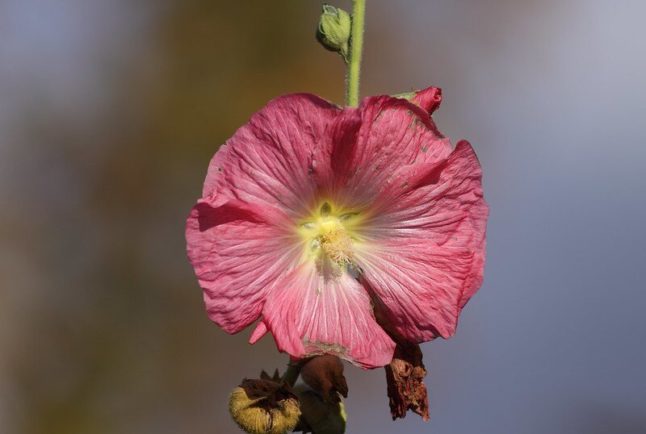
A staple feature of cottage gardens, hollyhock flowers are host plants for painted lady butterflies, the most widespread butterfly species on Earth. These midsummer biennials bloom on distinctive tall spikes with large flowers that also attract bees and hummingbirds.
- USDA Hardiness Zones: 3-9
- Examples of hollyhock varieties: Mars Magic (zones 3-9), Blacknight (zones 3-9), Queeny Purple (zones 3-8)
- Mature size: 6-8 feet tall
- Blooms: Wide, flat flowers in a wide array of colors; June-August
Fragrance: Hollyhock is unscented. - Watering: While soil should be kept moist while plants are first growing, hollyhock is fairly drought-tolerant once established.
- Sun exposure: Full sun to partial shade
Additional notes: Hollyhock will benefit from staking and cutting back stalks after flowering. It is prone to hollyhock rust.
Cost: Seed packets start at $3.95 at Eden Brothers
Wild Violet
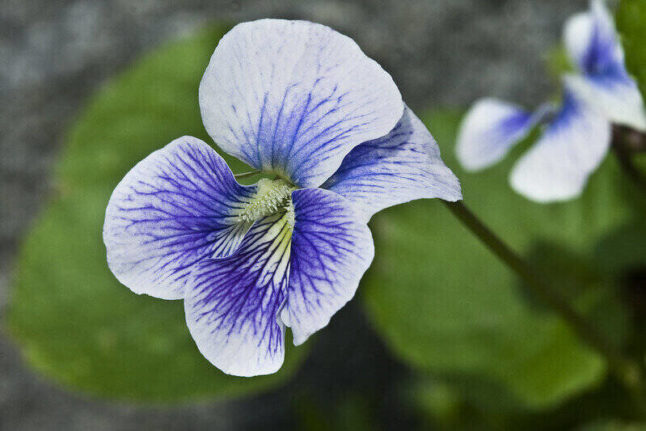
The humble wild violet may be decried as a weed by some gardeners, but, in fact, this widespread native plant is the primary host plant of the fritillary butterfly family. It also makes a great ground cover.
These early-spring bloomers provide a key nectar source for the start of pollination season, and some varieties can even be candied or added to salads for hungry humans.
- USDA Hardiness Zones: 3-9
- Examples of wild violet varieties: Common Blue Violet (zones 3-10), Prairie Violet (zones 3-8)
- Mature size: around 4 inches high and 6 inches wide
- Blooms: Small, heart-shaped purple or yellow flowers; March-June
Fragrance: Soft, sweet scent described as romantic - Watering: Keep soil moist, but not soggy
- Sun exposure: Light shade to partial shade
Additional notes: Violets aren’t prone to many diseases or pests, and are freely self-seeding. Certain seed varieties should be kept refrigerated until you’re ready to plant them. Sow seeds on the surface of a weed-free site in late fall or early winter to naturally break dormancy and encourage growth.
Cost: Seed packets start at $3 from Prairie Moon Nursery
Climbing Vines
Butterflies are curious creatures. When they’re exploring new garden territory, they particularly love having varied heights to pollinate. Whether you opt for trellises or hanging baskets, these climbing vines will take your butterfly garden to the next level – literally!
Passionflower
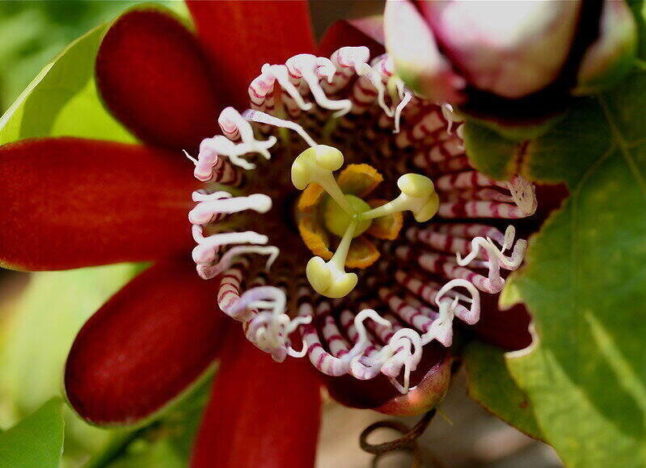
The stunningly unique passionflower vine will add a pop to your butterfly garden and attract a variety of butterflies, including the gulf fritillary and zebra longwing. Native to the southeastern U.S., these intricate flowers bear juicy edible fruits.
They also have a long history of medicinal use and are often recommended as a supplement to treat anxiety and sleep problems, among other conditions.
- USDA Hardiness Zones: Most varieties are perennial in zones 6-10, and some will also thrive in 5, 11, and 12
- Examples of passionflower varieties: Purple passionflower (5-9), blue passionflower (6-9), red passionflower (10-12)
- Mature size: 6-30 feet tall
- Blooms: Large, distinctive flowers in bright purple, blue, or red with prominent styles and stamens; flowers in spring through late fall and bears fruit from May to August
Fragrance: Sweet, tropical scent, similar to coconut - Watering: Give passionflower a deep watering immediately after planting and 1-2 per week during the growing season. This climbing vine doesn’t tolerate drought well, so if there’s no rain, give it about 1-1.5 inches per week.
- Sun exposure: Full sun to partial shade
Additional notes: Keep passionflower from running rampant in your yard by attaching it to a trellis or a frame. The flowers, which will bloom for only one day, do not need to be deadheaded and will bear fruit if fertilized. Prune the vines early in the spring to promote growth.
Cost: Blue passionflower seeds start at $5.95 at Eden Brothers
American Wisteria
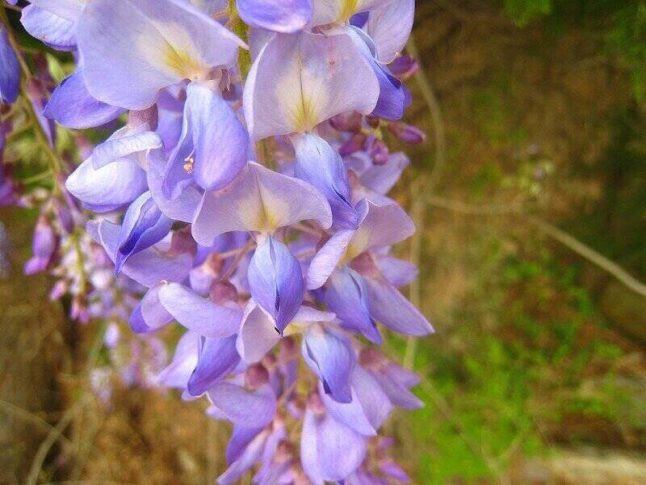
Looking for an alternative to Chinese wisteria that’s less aggressive but just as beautiful? Try its American cousin for gorgeous purple flowers that will attract plenty of butterflies without harming native ecosystems.
From skipper and duskywing butterflies to colorful Io moths, all sorts of species use American wisteria as both a host plant and a nectar source.
- USDA Hardiness Zones: 5-9
- Examples of American wisteria varieties: Dam B (zones 6-9), Nivea (zone 5), Amethyst Falls (zones 5-9)
- Mature size: 25-30 feet long
- Blooms: Blue, purple, pink or white flowers in clusters from 4-6 inches; May-June
Fragrance: Different scents based on variety – some musky, some sweet - Watering: American Wisteria thrives on consistent moisture and should be watered regularly, particularly when there’s less rain. Water it every 2-3 days or when the soil is dry to the touch.
- Sun exposure: Full sun to partial shade
Additional notes: American wisteria is flood-tolerant and prefers loamy soils and a south or southwestern orientation, away from cold winds and frost. It may become choloratic on alkaline soils, and should be grown in an isolated area to avoid choking out other flowers.
Cost: Since American wisteria can take years to mature from seed, it’s recommended you buy cultivated plants from a nursery for instant results. Plants start at $24.95 at Jackson and Perkins.
Virgin’s Bower
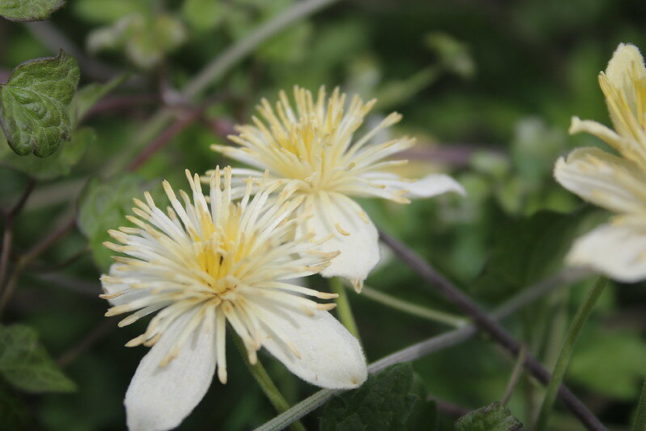
Native in the eastern U.S. from Texas to the Dakotas, virgin’s bower attracts many species of butterflies and moths, including the clematis clearwing. Also known as “devil’s darning needle” and “love vine,” this woody vine is a quick but harmless climber of trees and shrubs and can create a dense ground cover.
- USDA Hardiness Zones: 3-9
Examples of virgin’s bower varieties: N/A, though it’s often confused with Prairie Smoke and Sweet Autumn Clematis - Mature size: Climbs or spreads up to 20 feet
- Blooms: Delicate white flowers; July-September
- Fragrance: No noticeable fragrance
- Watering: Virgin’s bower should be kept moist, particularly in the warmer months. Avoid overwatering, though, as the clematis family is susceptible to mold and wilt.
- Sun exposure: Full sun to shade
Additional notes: Pruning will not affect flower growth, as blooms appear only on new vines. Virgin’s bower has no major insect or disease problems. It is not harmful to trees, but should be controlled by only purchasing male plants or propagating one vine asexually.
Cost: Seed packets start at $3 at Prairie Moon Nursery
Shelter Plants
When the sun goes down or the weather turns foul, butterflies look for shelter in woody plants with protective leaves. In addition to providing nectar and food for larvae, these flowering shrubs will keep butterflies safe when it’s time to take a rest from all that pollinating!
Buttonbush
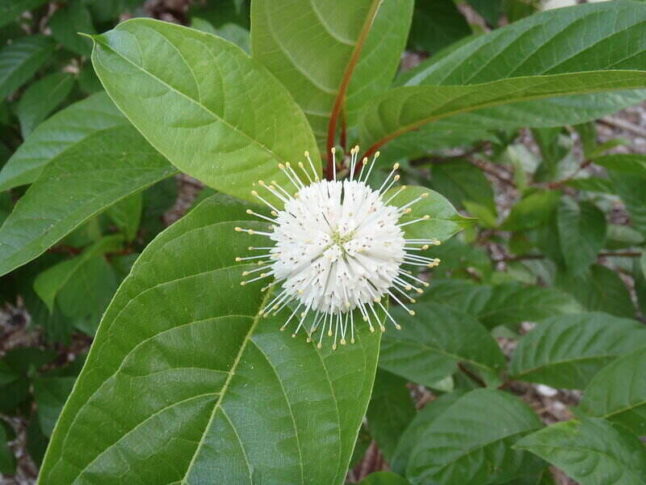
The distinctive blooms of the buttonbush attract monarch butterflies, skippers, and most other populations that may pass through your garden. They’re a perfect late summer butterfly plant alternative to the invasive butterfly bush. They’re also host plants for the hydrangea sphinx and titan sphinx moths.
These hardy wetland shrubs are native plants as far north as Canada, down south to Florida, and west to Texas and Nebraska. Some populations also exist in more southwestern climates, including New Mexico, Arizona, and Southern California.
- USDA Hardiness Zones: 4-11
- Examples of buttonbush varieties: Sputnik (zones 5-10), Keystone (zones 5-11), Sugar Shack (4-10)
- Mature size: 6-8 feet tall and wide
- Blooms: Unique white “pincushion” flowers; June-August
Fragrance: Smells like newly-mown hay when dried - Watering: Keep soil conditions moist and be ready for supplemental watering if planted in full sun, as buttonbush does not tolerate drought.
- Sun exposure: Full sun to partial shade
Additional notes: Buttonbush may appear unruly, and it can be maintained by cutting close to its base in spring before new growth.
Cost: 3-gallon pots start at $84.97 at Wilson Brothers Gardens
Serviceberry
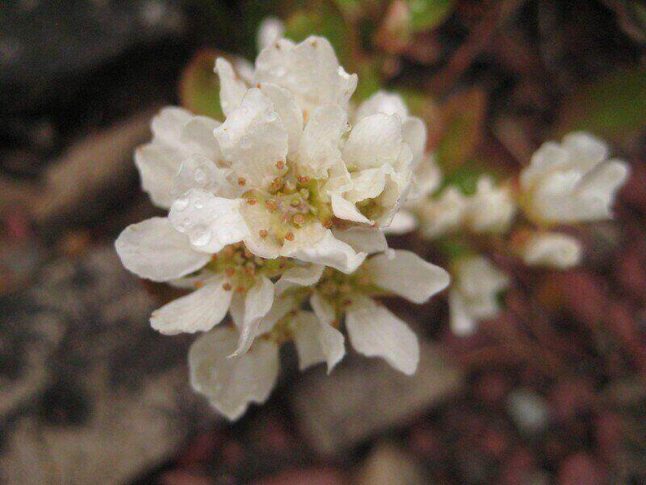
True to its name, serviceberry is a beneficial addition to any butterfly garden. With around 20 varieties native across most of the country, serviceberry provides both food and shelter for striped hairstreak and red-spotted purple butterflies, as well as blinded sphinx and small-eyed sphinx moths.
The edible berries of this large shrub or small tree are delicious for humans and songbirds.
- USDA Hardiness Zones: 3-9
- Examples of serviceberry varieties: Allegheny serviceberry (zones 4-8), Downy serviceberry (zones 4-9), Bartram’s serviceberry (zones 3-6)
- Mature size: Depends on variety, but typically 10 to 25 feet high
- Blooms: Delicate white flowers in clusters, March-April; red berries ripen in June
Fragrance: Lightly fragrant, but not distinct - Watering: Serviceberry is drought-tolerant once established and won’t need regular watering once it takes root. If newly transplanted, give it a gallon or two of water at the root zone several times a week.
- Sun exposure: Needs at least four hours of direct sun per day, but can thrive in partial shade.
Additional notes: Resistant to bugs and disease.
Cost: Varieties start at $79.97 at Wilson Brothers Gardens
Spicebush
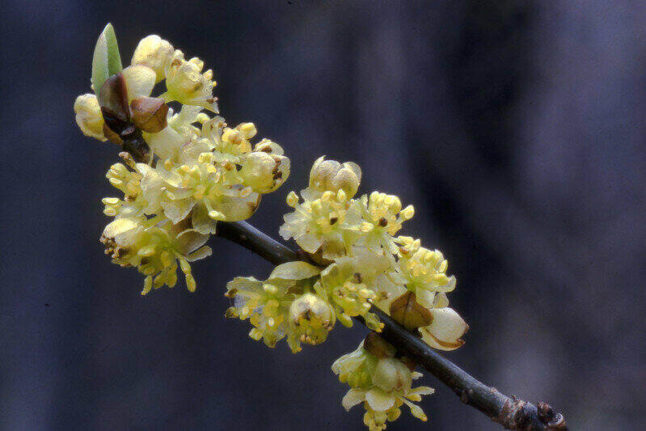
Native across the eastern U.S. and in parts of the Midwest, spicebush is so attractive to butterflies that it lends its name to the spicebush swallowtail, which uses it as a host plant. Other species that love this deciduous shrub include the eastern tiger swallowtail and the promethea silkmoth.
Nicknamed “forsythia of the wild,” the gentle yellow blooms will bring welcome color to your garden in early spring, before other plants have emerged from dormancy. The aromatic berries can be dried and ground into an allspice, while the bark and leaves can be brewed into tea.
- USDA Hardiness Zones: 4-9
- Examples of spicebush varieties: Northern spicebush (zones 4-9), Xanthocarpa (zones 4-9)
- Mature size: 8-15 feet tall and 6-15 feet wide
- Blooms: Delicate yellow flowers in April; red berries grow ripe in October
Fragrance: Rich, spicy scent from leaves, bark, and berries - Watering: Water regularly during the first growing season, but once established, spicebush is highly adaptable to soil conditions and won’t need regular watering outside of the rainfall conditions of its area.
- Sun exposure: Full sun to full shade
Additional notes: Spicebush does best in moist, well-drained soil, and will not require much hands-on care once these needs are met. Plants are dioecious, meaning male and female flowers grow on different plants – if you want berries, you’ll need both male and female varieties.
Cost: Bushes start at $19.95 at Greenwood Nursery
FAQ About Butterfly Garden Plants
Butterflies love sunlight, so choose a spot in your yard that will soak up sun all day – morning, noon, and evening.
Spring and fall are the best times to plant a butterfly garden, as the milder weather will make adjustments for new plants easier. You want your garden to bloom year-round!
Mulch is a natural weed killer, and will lessen the need for pesticides and herbicides in your garden, which will make it a happier butterfly home. Choose a natural shredded wood mulch or pine straw to keep it looking clean. Can’t decide? Check out our article, “Mulch vs. Pine Straw.”
Good for The Planet and Your Wallet
Building a butterfly garden is one of the best ways to help your local ecosystem, and it’s even easier if you stick to native species. These plants are naturally primed to thrive in your area and attract scores of butterflies. Many natives are perennials, which will come back on their own in years to come, making the setup for your butterfly garden a one-and-done job.
With this selection of butterfly-friendly native plants, you’ll be on your way to having a beautiful butterfly garden in weeks – without the hassle and cost of buying new plants year after year!
While we’ve compiled this list of great native plants for your butterfly garden, there are plenty of other species you might want to include. One way to get a butterfly garden designed with you in mind is to consult a local landscaping pro.
Got a handle on your butterfly garden, but need some help in the rest of your yard? LawnStarter’s landscape pros can help with that, too.
Main Photo Credit: Nikiko / Pixabay